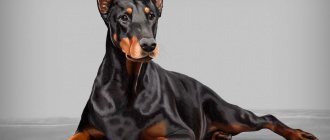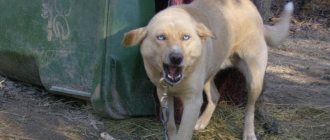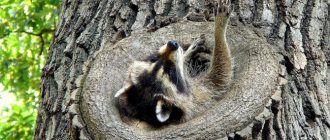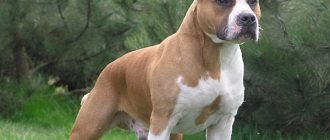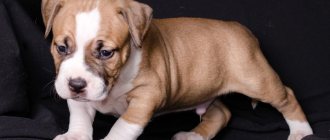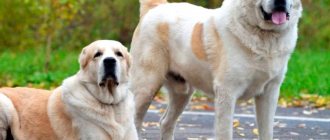The American Staffordshire Terrier is a versatile dog breed: staffs can work as guide dogs, rescuers or detectives. These are very energetic animals that require a lot of walks and movement. Active people should get an Amstaff to spend time with him traveling, fishing or playing sports. Modern Staffordshire Terriers are ideal for the role of a family dog: they are loyal, smart, brave and love children very much.
Amstaffs have very expressive facial expressions.
Amstaffs at home - a brief description of the breed
The American Staffordshire Terrier is a strong and muscular dog with an obedient and courageous character. These are very determined animals, but their character is more flexible than hot-tempered. Properly raised Amstaffs are kind, cheerful and balanced pets; they have expressive facial expressions and are very attentive to their owners, trying to imitate a person’s facial expression and adopt their mood.
Lack of attention from owners is detrimental to dogs of this breed.
The main characteristic features of Staffordshire Terriers:
- lively mind and intellect;
- good learning ability;
- expressive facial expressions;
- developed intuition;
- endurance;
- willingness to always protect the owners;
- fearlessness;
- loyalty to the owner and love for all family members;
- the desire to be the center of attention of your family;
- high threshold of irritability;
- need for physical activity;
- ease of maintenance at home.
Amstaffs do not show unmotivated aggression towards strangers and will never bark for trivial reasons, but an improperly trained dog can behave aggressively towards its relatives, and even get into fights.
When deciding whether to get an Amstaff, it is important to consider that these are dogs with character that will only obey a strong and self-confident leader. Important! Amstaffs never run away and will fight to the last, so it is important for the owner to properly train the dog from a very early age to obey unquestioningly and not react to stimuli in order to avoid problematic situations in the future.
Staffordshire Terriers are ideal sporting companions.
History of appearance
For the first time, history presents us with the Staffordshire Terrier as a fighter, bred specifically for the terrible and bloody spectacles of dog fighting, which were very popular in the 19th century.
The new breed appeared thanks to the union of a bulldog and a terrier.
The result is an excellent killing machine, combining the aggression of a bulldog and the mobility of a terrier. The dog fought to the last, despite his wounds and without feeling pain, which caused constant delight among the audience.
Over time, the names of the dogs changed: the animal was both a bull terrier and a pit bull terrier. Only towards the end of the 20th century was a permanent name assigned to the breed and its standard approved.
Today the Staffordshire Terrier is simply called the Staff or Amstaff. These names are shorter and more convenient.
After dog fighting lost its relevance, the dog began to be used as an impartial guard and a good hunter. The animal was given the status of a farm dog.
Today, many families prefer the Amstaff, keeping him as a pet. Responsible people who treat their four-legged friend with love have proven that a bruiser with a stern appearance can be turned into an affectionate and devoted pet.
Content Features
City residents who are just planning to purchase a dog may be faced with the question of whether it is worth keeping a Staffordshire Terrier in an apartment.
Amstaffs do not require complex care and do not need much space. If you provide the dog with sufficient physical activity during walks and indoor games, and monitor its diet, then you can live with a staff without any problems, even in a small apartment. Before taking home a puppy, it is necessary to create suitable conditions for the dog.
Place for a dog in the apartment
Staffies are very social creatures, they should be kept only in a house or apartment; from constantly being in an enclosure, these dogs become dull and become aggressive.
The Amstaff definitely needs to have its own place; it is good to put a thick bedding made of fabric on it, which will be easy to clean and wash. Staffordshire Terriers love to relax in armchairs, so you can allocate one old or non-staining one for the dog, the dog will be simply happy in it.
Staffies love to lie on their master's bed. If the dog is allowed to do this, then you need to immediately teach him that climbing on furniture is only possible with the permission of the person. This is important for maintaining the hierarchy: the most comfortable resting places should belong only to the leader of the pack.
Starting from the first months of life, the baby Amstaff will try to please its owners in everything.
How to train a dog to one place
The easiest way to teach a puppy the “place” command is when he is tired after a walk or has had enough to eat. You should take the baby in your arms, carry him to his bedding and clearly say “place” several times. If the pet tries to escape, you need to hold it slightly, repeating the command in a calm voice. When the puppy calms down, you need to pet him, praise him for his obedience and move a short distance away, observing the dog’s reaction.
When the baby falls asleep in his place, you can go about your business and repeat the exercise next time. After some time (this depends on the character of the puppy and the correct action of the owner), the dog itself will go to its place on command. At this time, it is important not to forget to praise the Amstaff and reward him with treats for correctly following the command.
Note! Amstaff puppies are constantly looking for something to chew, so owners should purchase various “chew toys” for their kids to save furniture and belongings.
Caging, advantages
For playful puppies, you can purchase a special large cage or box for air transportation, in which the animal will be locked while the owners are at work. The rest of the time, the cage should remain open, then the pet will perceive it as its own house or hole for sleeping, and not a place of confinement.
You should not punish your dog by locking him in a crate so that he does not have a negative attitude towards his shelter.
A crate for an Amstaff puppy is a home and a refuge.
The area of the room should be sufficient for the staff to stand in it at full height, lie down, fully stretched out and move around a little. When buying a box or crate for a puppy, you should take into account that the dog will grow. Be sure to place a drinking bowl there that is difficult to knock over, bedding and a few favorite toys.
In order for the Staffordshire Terrier to quickly get used to the cage and not experience negative emotions towards it, you can feed it only inside (of course, with the door open).
Additional Information. There are folding models of dog crates on sale that you can take with you on the road.
Pet food
Amstaffs are active dogs, but they are prone to overeating, so it is important to properly plan their diet.
During the first days of your puppy’s stay in the house, you should feed him the same way he was fed in the kennel; later, you can gradually switch the animal to another food.
Adult Staffies are fed twice a day, after a walk, and water should always be freely available. In very hot weather, you can feed the dog once a day (in the evening). It is necessary to periodically give your pet vitamin and mineral supplements, after consulting with your veterinarian.
Note! The diet is important for puppies: if the baby has not finished his portion, the leftovers are removed until the next feeding.
In order for an Amstaff to grow and develop normally, its diet must contain at least 30% animal proteins (mainly meat).
Feeding scheme and diet
The number of feedings per day depends on the age of the puppy:
- up to 2 months - 6 times a day, after walks;
- from 2 to 4 months - 5 times;
- from 5 to 11 months - 4 times;
- from one year to 1.5 years - 3 times.
An adult dog (from 1.5 years old) is fed twice a day.
For a balanced diet, ready-made store-bought food is best, but feeding with natural food is also possible, in which case 75% of the diet should be lean meat (beef, chicken or rabbit), cut into pieces. It can be diluted:
- offal (well cooked):
- porridges: millet, buckwheat, rice or corn;
- fish (without bones);
- fermented milk products;
- vegetables, fruits and herbs.
When feeding naturally, it is important to supplement the diet with vitamins and minerals.
Ready-made feeds contain all the necessary microelements.
It is strictly forbidden to give Staffordshire Terriers:
- pork;
- fat meat;
- sweets;
- spices and spicy foods;
- smoked meats and pickles;
- potatoes (especially boiled);
- fish or chicken bones;
- pearl barley and oatmeal porridge.
Food from the owner's table is not recommended; food for the dog should be prepared separately, only from products that are healthy for it.
How to choose a puppy
Staffordshire Terrier puppies should only be purchased from reputable breeders. Staff is not an animal with which you can experiment by purchasing babies from unverified people through an advertisement. Such puppies may be not purebred or, even worse, have serious mental disorders that even the most competent training cannot correct.
Temperament is passed on genetically.
When choosing a puppy, you need to observe not only him, but also the behavior of the adult members of his family. The small staff itself should not be either cowardly or overly aggressive. A moderately playful puppy should not be afraid of people, but show interest in them.
You should definitely pay attention to the puppy’s appearance: it must be well-groomed and without signs of disease. Shiny fur, clean ears and bright eyes, no unpleasant odor - all this indicates that the baby was given due attention and cherished.
Ask the breeder to show documents: pedigree, puppy card or veterinary passport, as well as those that confirm the absence of genetic diseases.
Do not hesitate to ask about worming and vaccinations: what drugs were used and when, when to carry out repeated anthelmintic procedures and which vaccine to give preference to. Be sure to clarify the issue of feeding and listen carefully to all the recommendations that the specialist will give you.
If possible, before purchasing, talk to owners who have this particular breed. This will help you look at the situation from the outside and objectively assess your capabilities. The breed is quite complex, and you must understand that you are not taking for yourself a toy, but a proud, intelligent and strong animal, which may encounter certain difficulties when raising it.
Physical activity and walks
Staffordshire Terriers are active dogs and need long walks during which they can run, play and obey their owner's commands. When walking in crowded places, the Amstaff must be muzzled and on a short leash.
Important! If the staff does not release its energy on walks, it may begin to spoil things in the house.
In summer, you can include swimming in a river or lake in your walk.
Care
Amstaffs are smooth-haired dogs, and therefore sensitive to cold. Some of my dogs are quite reluctant to go for walks even in rainy weather. I am not a fan of dressing dogs; I prefer active walking in winter, because the paws are the first to get cold, and no fur coat can save them. If it’s very cold (below -20 degrees), we walk very actively, and when I see that our paws are freezing, we go home. In this case, it is better to go for a walk more often.
Amstaffs do not tolerate heat very well, but they do not suffocate like dogs with a short muzzle. Naturally, I do not recommend going on a bike ride with your amstaff in extreme heat.
Sometimes caring for smooth-haired dogs is more difficult than long-haired ones, so don’t be fooled by the apparent ease of caring for this breed. Amstaffs shed, and the wool, like needles, gets stuck in the carpets. Shedding occurs 2 times a year: in spring and autumn. But now there are special brushes, furminators, that make life easier for owners.
As for bathing, I wash my dogs only before shows. But they are “clean spitters,” so there is no need for frequent water treatments.
Amstaffs have a wool smell, but it is not as pronounced as in many other breeds.
How long do staffs live?
A dog's lifespan is shorter than a human's, and it is important for owners to know in advance how long Staffords live. Amstaffs have good health and can rightfully be called long-livers. Their average lifespan is 10-12 years; with good genetics and proper care, a dog can even live up to 15.
Many factors influence how long Staffordshire Terriers live at home. Sufficient physical activity, a balanced diet and attention from the owners will help your pet live longer.
Typical diseases
All staffs are prone to the following diseases:
- osteoarthritis;
- dysplasia of the hip and elbow joints;
- allergy;
- hypothyroidism;
- urolithiasis disease;
- cardiovascular diseases;
- liver failure;
- cerebellar ataxia.
How many years staff live depends largely on their health status. In order to notice the onset of the disease in time and have time to take action, it is important to carefully monitor the dog’s condition and periodically take it for a veterinary examination.
Diseases
In general, Amstaffs are healthy and rarely vomit. With proper nutrition, a sufficient level of physical activity and proper care, owners, as a rule, do not have problems. However, like most purebred dogs, Staffordshire dogs have a number of diseases that are much more common than others.
The most common diseases of the Staff Terrier:
- skin allergies;
- UTI;
- autoimmune diseases;
- osteoarthritis;
- dysplasia of the hip and elbow joints;
- hypothyroidism;
- cerebellar ataxia (hereditary disease);
- demodicosis;
- diseases of the cardiovascular system.
Amstaff's main function
Staffordshire Terriers can be wonderful human companions, guard dogs, or even nannies for children.
Will it protect the owner and family?
Staffs are very devoted to their family, and are always ready to protect loved ones. It is important to train the dog to correctly assess the situation and unquestioningly obey all family members, otherwise it may begin to decide on its own who is dangerous, and it is very difficult to stop an angry dog.
Additional Information. Amstaffs serve in the canine units of the Russian Ministry of Emergency Situations. They were the ones who found the terrorists with explosives after the terrorist attack in the theater on Dubrovka.
Staffordshire Terrier and small children
Amstaffs, unlike many other breeds, easily distinguish children from adults. Staffordshire Terriers are considered one of the best "nannies" in the dog world; they adore children, treat them very carefully and tenderly, and are always ready to protect the child in case of danger. But very young children should not be left alone with staff.
Staffordshire Terriers simply adore children.
Dog instincts and possible problems
Staffordshire terriers definitely need to be raised and trained; these are very smart dogs that “on the fly” understand what the owner wants from them, but may refuse to obey due to stubbornness or the desire to become the leader of the “pack”.
To avoid problems in the future, it is necessary to build the correct hierarchy from the first day the puppy appears in the house, in which the dog is in last place, and all family members have unconditional authority. This can only be achieved if all household members adhere to the same line of behavior, without allowing concessions: if the grumbling of a puppy looks cute, then the dissatisfied growling of an adult dog at people is already a serious problem.
Important! Early socialization - frequent communication with other people and dogs will help prevent manifestations of causeless aggression towards strangers.
Amstaffs by nature are intelligent and social dogs; the excessive aggressiveness of Staffordshire Terriers is a consequence of improper upbringing. Senseless cruelty is not characteristic of this breed; they get involved in a fight only when there is a real threat.
American Staffordshire Terrier Exterior Standards
The first breed standard was created by W. Brandon in 1936. But it was approved by the International Canine Association only in 1972. According to him, the American Staffordshire Terrier belongs to the terrier group.
This is a strong, stocky dog with a muscular, proportional build, strong bones and a weight of no more than 30 kg. Belongs to medium breeds. The appearance is impressive, giving the impression of a formidable, strong dog.
Features of the head and muzzle
The wide head has clearly defined muscles. The skull is flat, almost square. The muzzle is of medium length, with a sharp transition from the forehead to the nose. The ears are set high and erect. Previously, only docked ones were recognized as the standard. Cupping is now prohibited in many countries. But the ears should be triangular, short, always erect or rose-shaped.
The eyes are round, small, wide and deep set. Eyelids dark. The jaws are strong, with a powerful grip, a scissor bite, and large teeth. Lips are black, not drooping. The zygomatic muscles are clearly defined. The nose is large and black, but in blue individuals it can be gray.
Description of physique
The physique is powerful, the dog seems large for its height. The chest is wide, the ribs are convex. The neck is thick, widening towards the shoulders. Suspension is unacceptable, the skin fits tightly. The belly is tucked, the withers are muscular, the back is short and wide, the loin is convex. The tail is short and not docked. Set low, tapering towards the end. It cannot be crocheted, nor can it be thrown over the back.
Limbs
The forelimbs are powerful, straight, widely spaced, elbows close to the body. The hind legs are muscular, the metatarsals are short. The hocks are turned back. The limbs are parallel. The paws are arched and gathered into a ball. The dog moves easily, freely, springily. Ambling or swaying while moving is unacceptable.
Description of the appearance will be incomplete without photographs:
Staff appearance
Colors and coat characteristics of Staffordshire Terriers
The coat is dense, short and smooth. It feels hard to the touch and fits well to the body. The standard allows several color options:
- black usually without shades, small spots on the nose and paws are possible;
- black and white staffs have white spots on the head, paws, neck, back;
- the color of the coat can be from blue to blue or with a silver coating;
- red or brown;
- fawn or sand;
- Brindle Staffordshire Terriers can be light or dark brown with spots;
The most common colors are white-sable, white-black and brindle. The blue color is unusual; not all clubs recognize it. Dogs of any color can have white spots. They should occupy no more than 80% of the body surface. Pure white color is undesirable, although the standard allows it.
The photo shows what colors staffs can have:
Staff red color
American Staffordshire Terrier color
Staff black and white
Amstaff brindle color
Varieties
The American Staffordshire Terrier is descended from bulldogs, terriers. Therefore, sometimes breed varieties are identified that are not recognized by the standard. There are certain differences between them and real Amstaffs:
- English Staffordshire Bull Terrier or Staff Bull is taller, the muzzle is wide and short;
- the American pit bull has retained more features of fighting breeds, its limbs are shorter;
- the bull terrier is squat, the shape of the head is ovoid;
- the dwarf bull terrier has a height of no more than 36 cm, weight up to 8 kg.
Within the breed, bulldog-shaped Staffords are distinguished. Their weight is more than 40 kg, their build is rough, and their neck is short. They are inactive and their movements are constrained. And terrier-like Amstaffs are distinguished by high activity, a narrower muzzle, and an elegant body. They weigh less than 30 kg and are sometimes considered a dwarf breed.
Disqualifying faults
Amstaff is a fairly young breed. But the requirements of the standard are clear, deviations are not allowed. There are several disadvantages due to which a dog will not be allowed to participate in exhibitions:
- slowness, lethargy;
- deviations from height and weight standards;
- wavy soft wool;
- light eyes;
- pink nose, lips or eyelids;
- a long tail;
- hanging skin, dewlap on the neck;
- overshot lower jaw;
- drooping ears;
- black and tan or liver color.
